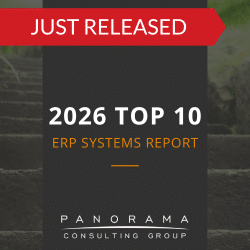As the logistics industry grows more complex and demand grows more unpredictable, artificial intelligence (AI) is becoming essential for optimizing logistics operations.
Today, we’re exploring recent AI trends in logistics and sharing strategic considerations for successful implementation.
AI Trends in Logistics to Keep on Your Radar
AI’s role in logistics is growing rapidly. Whether you add AI capabilities to your enterprise software or directly to your factory floor, it has the potential to increase efficiency and optimize your supply chain operations.
1. Predictive Analytics: Enhancing Forecasting and Decision-Making
AI-powered predictive analytics has become a cornerstone in logistics, enabling companies to better anticipate demand, manage risks, and optimize resources.
By analyzing vast amounts of historical and real-time data, AI can predict future trends with greater accuracy than traditional forecasting.
For example, logistics companies can now anticipate potential disruptions due to weather, supplier delays, and geopolitical factors. Then, they can proactively adjust inventory levels, re-route shipments, or increase production as necessary.
This trend is particularly critical for just-in-time (JIT) supply chains, where delays can be costly. AI’s ability to provide real-time insights helps mitigate these risks, making predictive analytics one of the most valuable AI benefits in logistics.
Our ERP selection consultants frequently help companies move to the cloud and implement AI-powered ERP systems to integrate their data and enable more accurate forecasting.
(Learn more about AI in business decision-making.)
2. Autonomous Vehicles: Enhancing Efficiency in Fleet Management and Delivery
While wide scale adoption of fully autonomous trucks may be many years away, semi-autonomous technologies, such as advanced driver assistance systems (ADAS), are already being integrated into logistics fleets. These systems assist human drivers by automating lane-keeping, adaptive cruise control, and collision avoidance.
AI is also playing a pivotal role in optimizing existing vehicle fleets to reduce operational costs and improve delivery times.
For example, many companies are using AI to optimize route planning and fleet management. AI-powered algorithms analyze real-time traffic data, road conditions, and vehicle performance to determine the most efficient routes. This “intelligent routing” helps businesses meet tight delivery windows and lower operating costs, even as fuel prices and delivery demands fluctuate.
2025 Clash of the Titans
SAP, Oracle, Microsoft, and Infor each have a variety of systems that can support data-driven decision-making. We surveyed customers of these four vendors to find out what their selection and implementation process was like.
3. Warehouse Automation: Streamlining Fulfillment Centers
Warehouses are becoming increasingly automated with AI-powered robots and machines. Advanced computer vision and AI algorithms allow these machines to navigate complex environments, pick products from shelves, and efficiently organize them for shipping.
The benefits for logistic businesses include reduced labor costs, minimized human error, and accelerated order fulfillment.
This automation is especially crucial in large-scale warehouses that handle millions of items daily.
Warehouse automation is also proving beneficial for organizations that want to scale their operations without proportionately increasing labor costs.
4. AI-Enhanced Supply Chain Visibility: Real-Time Tracking and Transparency
A growing number of logistics providers are adopting AI solutions to provide real-time tracking of shipments and improve overall supply chain visibility. By utilizing AI-powered sensors and the Internet of Things (IoT), businesses can monitor the status of goods in transit, track delivery vehicles, and manage inventory levels.
Furthermore, AI systems can identify patterns in tracking data, helping companies uncover inefficiencies or bottlenecks that might otherwise go unnoticed.
Real-time visibility into the supply chain facilitates collaboration and enables faster responses to delays or other issues. This not only increases operational efficiency but also strengthens customer relationships, as companies can offer more reliable delivery estimates and proactive customer service.
Do the Benefits Outweigh the Challenges of AI in Logistics?
The implementation of AI in logistics offers clear advantages, but it also comes with challenges that require careful planning.
1. Cost Reduction through Process Optimization vs. Complexity in Integration and Customization
Benefit:
AI can streamline logistics operations, leading to significant cost reductions.
Challenge:
The challenge lies in the complexity of integrating AI into existing logistics systems.
AI solutions often need to be customized to align with a company’s specific processes, and many logistics companies operate with legacy systems that are not easily compatible with AI technologies. This means the integration process can be time-consuming and technically challenging, requiring specialized skills that may not be readily available in-house.
Additionally, the need for continuous system updates and maintenance adds complexity and potential costs, especially when adapting AI to fit unique workflows.
Our ERP implementation consultants often recommend a phased implementation approach to clients with complex operations. Starting with non-critical modules allows companies to identify and resolve issues before they disrupt core operations.
2. Enhanced Customer Experience vs. Managing AI Bias in Decision-Making
Benefit:
AI enhances the customer experience by providing real-time tracking, accurate delivery forecasts, and more personalized service.
Challenge:
One significant challenge in using AI to enhance customer experience is managing potential AI biases in decision-making.
AI algorithms rely on historical data, which can sometimes embed biases that affect how different customer segments are treated.
For example, certain customer locations may be deprioritized due to perceived delivery inefficiencies.
Ensuring that AI systems are regularly audited and monitored to avoid bias is crucial but often difficult to achieve. Overcoming this challenge requires consistent oversight and frequent adjustments.
3. Improved Risk Management and Resilience vs. Over-Reliance on AI Predictions
Benefit:
AI significantly enhances risk management in logistics by providing predictive insights that help companies prepare for potential disruptions.
Challenge:
A major challenge arises when companies become over-reliant on AI predictions.
While AI can process vast amounts of data and identify patterns, it is still subject to limitations, particularly when facing unprecedented events or situations where historical data is scarce.
For example, during natural disasters, where on-the-ground conditions can change rapidly, AI systems may struggle to provide real-time adjustments. Relying too heavily on past data or simulations might lead to decisions that overlook emerging challenges.
Supply chain managers must balance AI-driven predictions with human intuition and situational awareness to ensure decisions remain flexible and adaptable.
4. Increased Operational Efficiency Through Automation vs. Workforce Displacement and Reskilling Needs
Benefit:
AI-driven automation greatly improves operational efficiency in logistics by accelerating processes like warehouse management, picking and packing, and inventory sorting.
Challenge:
While automation drives efficiency, it also raises concerns about workforce displacement.
Employees may fear losing their jobs as AI and robots take over repetitive tasks. This can lead to resistance within the organization, impacting the successful implementation of AI systems.
Companies must invest in reskilling their workforce so employees can transition to new roles that complement AI technology. This requires a commitment to continuous training programs and job redesign.
Our change management consultants often help companies conduct organizational assessments to help them understand what it will take to get their teams ready, willing, and able to embrace change.
5. AI-Enabled Supply Chain Visibility vs. Data Security and Privacy Risks
Benefit:
AI enhances supply chain visibility, allowing logistics companies to track shipments, inventory levels, and vehicle locations in real time.
Challenge:
With greater supply chain visibility comes the challenge of managing data security and privacy risks.
AI systems rely on large amounts of sensitive data, including supplier information, customer details, and operational analytics. If these datasets are not adequately protected, they become attractive targets for cyberattacks.
Companies must invest heavily in cybersecurity to ensure that AI-powered systems are safeguarded against threats. This requires specialized expertise and significant financial resources to maintain up-to-date security measures.
Strategic Recommendations for Successful AI Implementation in Logistics
For CEOs and logistics executives, the decision to invest in AI requires a thoughtful, strategic approach. If you’re unsure how to assess your organization’s AI maturity or identify the most promising use cases, our AI Readiness and Enablement team can help you determine where to start and how to build a roadmap that aligns with your operational goals.
1. Focus on High-Impact Areas First
Rather than trying to implement AI across all areas of the business simultaneously, focus on specific functions where AI can deliver the greatest impact.
For example, you could start with AI-powered predictive analytics to improve demand forecasting or start with warehouse automation to accelerate order fulfillment.
By targeting high-priority areas first, you can demonstrate quick wins and build momentum for broader AI adoption across the organization.
2. Collaborate with Independent Consultants for Software Selection
Selecting the right AI tools for your logistics operations can be challenging, given the wide range of solutions available on the market.
Working with independent consultants who specialize in enterprise software selection can help you navigate this complex landscape. These consultants can provide unbiased advice based on your specific needs, ensuring that you select the right solutions for your business.
When our ERP consulting firm conducts software selections, we start by helping companies identify their current pain points and functional requirements. This enables us to create requests for proposal (RFPs) for vendors and determine which vendors have the most promising responses.
3. Prioritize Data Governance and Infrastructure Upgrades
To fully harness the power of AI, your organization needs robust data governance practices and an infrastructure capable of supporting large-scale AI applications.
Ensure that your data is accurate, secure, and readily accessible to AI systems. This may require upgrading your existing IT infrastructure or investing in cloud-based platforms that offer scalability and flexibility.
Navigating the Future of AI in Logistics
The integration of AI in logistics is no longer just a forward-looking concept; it’s a reality that’s transforming supply chains around the globe. The latest AI trends in logistics are driving cost efficiencies, improving customer satisfaction, and increasing supply chain resilience.
While AI benefits in logistics are substantial, it’s crucial to approach adoption strategically, keeping in mind the challenges and risks.
Contact our business software consultants to learn how to make your logistics operations thrive in the age of digital transformation.














